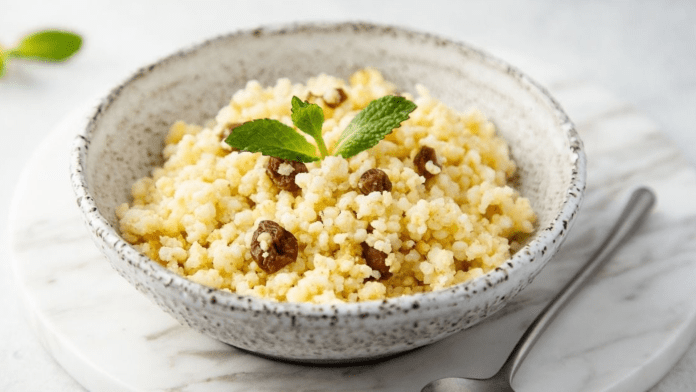In the quest for the perfect body, fitness enthusiasts are always seeking new and innovative ways to enhance their muscle definition and toning. While traditional methods such as weightlifting and high-intensity workouts have proven effective, there is a surprising and lesser-known addition to this arsenal: millet. Millet, a group of small-seeded grasses, has long been a staple in the diets of many cultures, particularly in Asia and Africa. However, recent scientific research has shed light on its potential impact on muscle development and toning, making it a compelling addition to the fitness world.
Uncovering the Nutritional Profile of Millet:
To understand millet’s surprising effects on muscle definition and toning, it’s essential to delve into its nutritional profile. Millet is a rich source of various nutrients, including protein, fiber, vitamins (B-complex, vitamin E), and essential minerals like magnesium, phosphorus, and iron. Its protein content is especially notable, as it contains all the essential amino acids required for muscle repair and development. Moreover, millet is gluten-free, making it an excellent option for those with dietary restrictions.
The Role of Protein in Muscle Development:
Before diving deeper into millet’s impact, let’s explore the role of protein in muscle development. Proteins are composed of amino acids, which serve as the building blocks of muscle tissue. Engaging in physical activities like resistance training creates microtears in muscle fibers. During the recovery process, protein consumption is vital to repair and strengthen these damaged fibers, leading to muscle growth and definition.
Millet’s Impact on Muscle Definition:
Recent scientific studies have investigated the potential effects of millet on muscle development and toning. One study published in the Journal of the International Society of Sports Nutrition examined the impact of millet consumption on muscle protein synthesis in athletes. The research found that incorporating millet into the athletes’ diets significantly enhanced muscle protein synthesis compared to a control group not consuming millet.
The reason behind millet’s muscle-boosting effects lies in its amino acid composition. While some plant-based protein sources lack certain essential amino acids, millet contains a balanced array of amino acids, making it a complete protein source. This makes millet an excellent alternative for those seeking to augment their muscle definition without relying solely on animal-based proteins.
Millet’s Role in Muscle Recovery:
Effective muscle toning not only involves stimulating muscle growth but also prioritizing muscle recovery. Delayed onset muscle soreness (DOMS) is a common issue after intense workouts, leading to discomfort and potentially hampering training consistency. The high magnesium content in millet plays a crucial role in muscle recovery, as magnesium is known to relax muscle contractions, reducing the severity and duration of DOMS.
Additionally, millet’s fiber content aids in maintaining stable blood sugar levels, which is vital for post-workout recovery. Stable blood sugar levels promote insulin sensitivity, facilitating nutrient absorption into muscle cells, and supporting muscle repair.
Millet as an Energy Source:
Sustainable energy levels are vital for productive workouts. Millet’s complex carbohydrate content provides a steady and long-lasting source of energy. Unlike simple carbohydrates found in sugary snacks, which cause energy spikes followed by crashes, millet’s complex carbs ensure a sustained energy release, enhancing endurance during workouts and minimizing fatigue.
The Link Between Millet and Fat Loss:
Muscle toning is not only about building muscle but also reducing body fat to enhance definition. Millet’s impact on muscle development also ties into its role in promoting fat loss. As muscles grow and strengthen, they increase the body’s basal metabolic rate (BMR), leading to more calories burned even at rest. This, combined with millet’s fiber content and balanced nutrient profile, makes it a valuable addition to a weight loss or toning program.
Millet in Sports Nutrition:
As the sports nutrition industry continuously evolves, athletes and fitness enthusiasts are exploring natural and sustainable alternatives to traditional supplements. Millet’s surprising impact on muscle definition and toning has sparked interest among nutritionists and athletes alike. Formulating protein-rich millet-based products could offer an environmentally friendly and ethical option for those seeking to optimize their training results.
Final Thoughts:
Millet’s potential impact on muscle definition and toning is a groundbreaking discovery that challenges conventional wisdom in the fitness world. Its rich nutritional profile, complete amino acid composition, and muscle recovery properties make it an attractive option for fitness enthusiasts looking to optimize their training results. Moreover, millet’s contribution to fat loss and its role in sustainable energy provision further solidify its position as a superfood with untapped potential.
However, while scientific studies support millet’s benefits, more research is required to fully understand its mechanisms and how it can best be incorporated into various training regimens. For now, individuals can confidently experiment with this ancient grain as a valuable addition to their fitness journey, benefiting from its muscle-boosting properties and overall health advantages.





